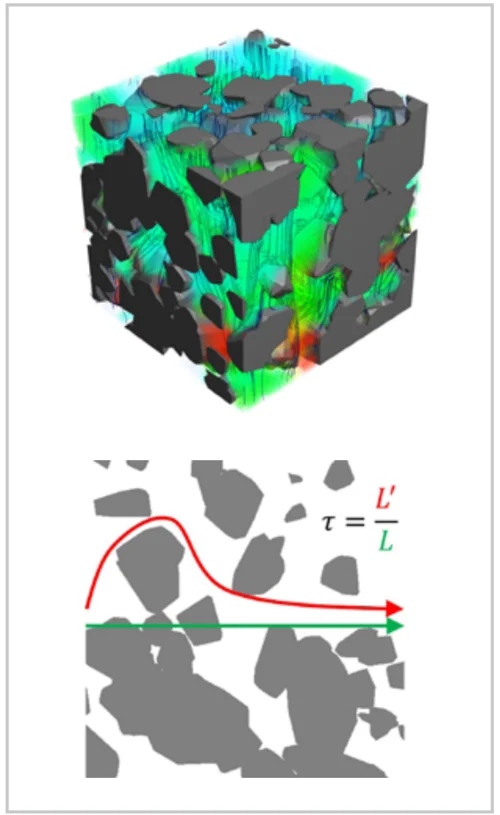Pairing fast charging and high energy density in batteries
by optimizing the microstructure of electrode materials with the simulation software GeoDict
Fulfilling the vast potential of electromobility and earning mainstream acceptance hinges on mastering the challenge of pairing fast charging and high energy density in batteries. This task should not rely entirely on finding novel electrode material constituents with these conflicting and extreme technical pre-requisites, but must aim at solving this dilemma through the microstructural optimization of current electrode materials.
Ionic transport processes play a critical role on the microscale during charging and are mainly governed by the microstructure and texture of the electrode materials.
An experimental optimization by trial-and-error is time consuming, costly, and excludes the possibility of assessing the impact of single parameters on the complex battery system.
Addressing this challenge, the advanced simulation software GeoDict has been built for import and segmentation of CT scans of electrode materials or virtual generation of realistic 3D-microstructures with a representative volume (REV). This easy-to-use software is applied to improve the microstructure of electrode materials and drive genuine innovation in battery research.
The challenge of unifying fast charging and high energy density in batteries
- High-energy anodes for fast charging
- Optimization of anode kinetics
- Targeting of microstructure and texture
Lithium-ion batteries still face challenges in energy density, fast charging, and cost efficiency. Advanced electrode materials are essential to overcome the limitations in electromobility and efforts are ongoing to combine fast charging capabilities with high energy density.
The transport pathways for the Li-ions are often restricted if high-energy anodic materials are charged, leading to irreversible accumulations of reactive metallic lithium and resulting in reduced cell capacity, high inner resistances, shortcuts and, finally, safety issues.
The absence of systematic approaches in R&D makes it challenging to optimize key anode kinetics parameters, such as particle size, shape, distribution, tortuosity, and porosity. Currently, their refinement relies on costly and time-consuming trial-and-error experiments. This method often fails to isolate the impact of individual parameters within the complexity of a battery system.
GeoDict substitutes and complements this experimental approach by providing powerful software tools to simulate battery cycling as well as geometric and transport properties on realistic microstructures and to optimize the performance of the anodic material.
Math2Market GmbH offers GeoDict as the optimal simulation solution and is ready to help in developing electrode materials enhanced for fast charging.
- GeoDict runs detailed 3D simulations of complex battery systems, starting from the microstructure of the electrodes up to charging of the virtual battery.
- GeoDict simulations reveal the impact of single parameters on the battery performance
Rounded off with individualized training and support, the modular GeoDict software is perfectly designed to adapt to any R&D workflow.
Math2Market joins in your efforts and helps in applying GeoDict to tackle specific issues. In a tailored evaluation project, we train you in using GeoDict optimally for modelling of microstructures, simulation and prediction of properties, as well as visualization and interpretation of simulation results.
GeoDict supports a variety of import and export file formats (e.g. MATLAB®, Microsoft Excel®), and can mesh and export the generated structures. In this way, GeoDict can be seamlessly integrated into an existing workflow with other software tools. Besides,
GeoDict can be controlled and run through user-created python macros and scripts.
After the training, the professional support of Math2Market focuses on keeping the user in the road to success. Yearly software updates guarantee that GeoDict remains at the forefront of scientific developments in material microstructure design.
The effective ionic diffusivity in the electrolyte is a key parameter to optimize electrode materials for fast charging. It depends critically on the tortuosity τ, which is a measure of the curvature of the ion transport pathways due to the microstructure of the electrode. A lower tortuosity leads to higher diffusion of the Li-ions.
The critical parameter for the active particles in the electrode is the specific active surface, which must be maximized to offer sufficient electrochemically active sites for ion transfer.
Optimizing tortuosity and specific active surface will prevent bottlenecks for Li-ion transport and intercalation and, therefore, restrict Li-plating. The calculation of the microstructure‘s tortuosity and the effective diffusivity in the electrolyte is carried out using the DiffuDict module. The specific surface area of the active particles is determined within the GrainFind module.
In the next step, structural parameters like solid-volume-percentage, porosity, and size distribution, shape, and orientation of particles are optimized in the GrainGeo module. A charging simulation with BatteryDict then proofs the reduction of Li-plating.
The Volkswagen Group Innovation is investigating the design guidelines for fast charging anodes using this workflow:
- Increasing active graphite surface by e.g. smaller particle size
- Increasing effective electrolyte diffusion by e.g. particle orientation
- Orienting the particles to expose the prismatic surfaces for Li-ion exchange
Conclusions
- Reaching the goal of unifying high energy density, low cost, a superb lifetime and fast charging for batteries starts with understanding and fine-tuning the materials at the microscale.
- The simulation software GeoDict constitutes a true digital material laboratory, enabling the digital characterization and design of innovative battery materials for the mobility of tomorrow.
- GeoDict is the ultimate R&D toolkit to analyze and optimize the battery microstructure and can be easily integrated into any workflow.
- Math2Market provides strong and competent scientific support to tackle specific R&D challenges and is proud of assisting its clients to succeed in their development goals.
- Example of simulations result: Simulate and optimize transport properties, such as effective ionic diffusivity, geometric properties like tortuosity, and the specific surface of the active particles to prevent Li-plating in anodes.
- Volkswagen has successfully integrated GeoDict into its Group Innovation processes to investigate electrode microstructure while developing design guidelines for high energy electrodes, fast charging, and other research projects.















![[Translate to English:] [Translate to English:]](/fileadmin/_processed_/f/1/csm_202407-ConsideringAnisotropicDiffusion_4d415033c3.webp)

![[Translate to English:] [Translate to English:]](/fileadmin/_processed_/6/4/csm_ShowCase_2100510_PageBanner_fc25f61c81.webp)